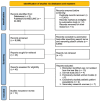A Review of the Tear Film Biomarkers Used to Diagnose Sjogren's Syndrome
- PMID: 39408709
- PMCID: PMC11476667
- DOI: 10.3390/ijms251910380
A Review of the Tear Film Biomarkers Used to Diagnose Sjogren's Syndrome
Abstract
This literature review looks at Sjogren's Syndrome (SS), a chronic autoimmune disorder affecting exocrine glands, particularly the lacrimal and salivary glands. SS manifests as ocular and oral dryness, with severe complications like visual dysfunction and corneal perforation, as well as systemic implications, such as interstitial lung disease and lymphoma. This review explores the use of tear film biomarkers to diagnose SS, emphasizing the significance of their identification in aiding clinical diagnosis and differentiation from other diseases. This study identified and analyzed 15 papers, encompassing 1142 patients and employing various tear sample collection methods. Tear biomarkers were categorized by function and explored in-depth. Categories include (1) antimicrobials, antivirals, and antifungals; (2) components of immune regulation; (3) components that regulate metabolic processes; and (4) inflammatory markers. Noteworthy findings include the potential diagnostic values of tear lysozyme, lactoferrin, dinucleoside polyphosphates, cathepsin, defensin, antibodies, epidermal fatty acid-binding protein, HLA-DR, ADAM10, aquaporin 5, and various miRNAs and mRNAs. Overall, our understanding of SS tear film composition is enhanced, providing valuable insights into the pathogenesis of SS and offering a foundation for future diagnostic and therapeutic advancements in autoimmune conditions affecting the ocular surface.
Keywords: Sjogren; biomarker; dry eye; lacrimal gland; tear.
Conflict of interest statement
The authors declare no conflict of interest.
References
-
- Izmirly P.M., Buyon J.P., Wan I., Belmont H.M., Sahl S., Salmon J.E., Askanase A., Bathon J.M., Geraldino-Pardilla L., Ali Y., et al. The Incidence and Prevalence of Adult Primary Sjögren’s Syndrome in New York County. Arthritis Care Res. 2019;71:949–960. doi: 10.1002/acr.23707. - DOI - PMC - PubMed
-
- NIDCR . Sjögren’s Disease. National Institute of Health; Bethesda, MD, USA: 2023.
-
- Luppi F., Sebastiani M., Silva M., Sverzellati N., Cavazza A., Salvarani C., Manfredi A. Interstitial lung disease in Sjögren’s syndrome: A clinical review. Clin. Exp. Rheumatol. 2020;38:291–300. - PubMed
Publication types
MeSH terms
Substances
LinkOut - more resources
Full Text Sources
Medical
Research Materials


